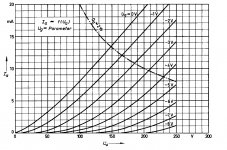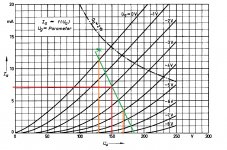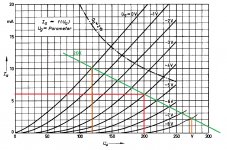Hello,
want to build a PP pre with E80CC output tubes and have a plate to plate 10K Ohm, 600 Ohm secondary trannie. Have read some literature about calculation of the correct working point of the tubes for class A, but have some difficulties to understand the topic.
What I understood is, the correct primary impedance has to be calculated for the double idle current of one tube. So in fact, if one chooses 150V per tube and 4mA per leg of the trannie, than it should be 8mA for one leg and 150V. Result for this operatin point is 18K Ohms.
Could somebody please correct my calculation, if wrong.
Is there a possible class A working point for this tube that I could make use of with this 10K output trannie? Max. voltage of the power supply will be 300V, current is freely available.🙂
want to build a PP pre with E80CC output tubes and have a plate to plate 10K Ohm, 600 Ohm secondary trannie. Have read some literature about calculation of the correct working point of the tubes for class A, but have some difficulties to understand the topic.
What I understood is, the correct primary impedance has to be calculated for the double idle current of one tube. So in fact, if one chooses 150V per tube and 4mA per leg of the trannie, than it should be 8mA for one leg and 150V. Result for this operatin point is 18K Ohms.
Could somebody please correct my calculation, if wrong.
Is there a possible class A working point for this tube that I could make use of with this 10K output trannie? Max. voltage of the power supply will be 300V, current is freely available.🙂
Attachments
Last edited:
The working point for PP with 10K plate-to-plate load is the same as the working point for SE with 5K load (of course, PP stage will draw twice as much idle current simply because you now have two tubes).
Anyway, 5K load is probably not the best choice for the tube with internal resistance of about 10K. Technically you can raise plate-to-plate load even with existing transformer by using higher than 600 Ohm load on secondary, but the outcome depends heavily on the particular transformer.
Anyway, 5K load is probably not the best choice for the tube with internal resistance of about 10K. Technically you can raise plate-to-plate load even with existing transformer by using higher than 600 Ohm load on secondary, but the outcome depends heavily on the particular transformer.
Hello and thanks for your answer.
The transformer has another 150 Ohm secondary tab. Maybe this tab should be used for 600 Ohm loads and it will lift the 5K load four times into a 20K load?
The transformer has another 150 Ohm secondary tab. Maybe this tab should be used for 600 Ohm loads and it will lift the 5K load four times into a 20K load?
Last edited:
Not enough data. There are multiple possible OPs for those conditions.
What input voltage (RMS) do you have?
What input voltage (RMS) do you have?
In Front of this E80CC output tube is the phase splitter. Into the phase splitter goes the line level inputs. So input voltage of phase splitter is 1.5 Volts.
That's not the information I asked for.
Anyway, for a 5K load (10K plate-to-plate), I'd go for something like 150V and 7mA.
Max input voltage (for each input in PP) - 2Vp-p (1.41Vrms)
Max jutput voltage at 600 Ohm load - 9.3Vp-p (6.6Vrms)
For a 20K load (40K plate-to-plate) it's rather 200V and 6mA.
Max input voltage (for each input in PP) - 4Vp-p (2.83Vrms)
Max jutput voltage at 600 Ohm load - 19Vp-p (13.43Vrms)
But using 600 Ohm load at 150 Ohm tap is no better than using 2.4K load at 600 Ohm tap, and results again depend on the transformer.
Anyway, for a 5K load (10K plate-to-plate), I'd go for something like 150V and 7mA.
Max input voltage (for each input in PP) - 2Vp-p (1.41Vrms)
Max jutput voltage at 600 Ohm load - 9.3Vp-p (6.6Vrms)
For a 20K load (40K plate-to-plate) it's rather 200V and 6mA.
Max input voltage (for each input in PP) - 4Vp-p (2.83Vrms)
Max jutput voltage at 600 Ohm load - 19Vp-p (13.43Vrms)
But using 600 Ohm load at 150 Ohm tap is no better than using 2.4K load at 600 Ohm tap, and results again depend on the transformer.
Attachments
Many thanks for your hints, TG. I think for using the trannie with a 5K per leg/ 600 Ohm out that could work out great, as it means 300V in total from the PSU, exactly what I hoped for.
You're welcome 🙂
It doesn't. You'll need 150V B+ for this setup (well, maybe 155-160V to compensate for bias and DC voltage drop on the primary). Two halves of PP circuit work in parallel, not in series.as it means 300V in total from the PSU, exactly what I hoped for.
Oh, I see, my fault.
That means with such a low 5K primary impedance we will have no choice to rise up voltage because it will increase the necessary plate impedance of the tubes.
That means with such a low 5K primary impedance we will have no choice to rise up voltage because it will increase the necessary plate impedance of the tubes.
That's true, and because of that with lowish loads you generally want to work in the high current/low voltage area rather than vice versa.
But what's even more important, with higher voltages the load line will go above the maximum plate dissipation curve, which is not acceptable for any serious design.
But what's even more important, with higher voltages the load line will go above the maximum plate dissipation curve, which is not acceptable for any serious design.
Thanks for the explanations.
The trannie I refer to was used by Shindo for an E80CC PP design. But they used the 150 Ohm out for 600 Ohm loads. Maybe thats the trick in the game. Otherwise its not the optimal choice, thats correct. From its nature, it was designed for 6V6 PP preamps. Maybe I should search for a noval version of this tube.
The trannie I refer to was used by Shindo for an E80CC PP design. But they used the 150 Ohm out for 600 Ohm loads. Maybe thats the trick in the game. Otherwise its not the optimal choice, thats correct. From its nature, it was designed for 6V6 PP preamps. Maybe I should search for a noval version of this tube.
Noval 6V6 does exist - it's a Soviet 6P1P. EL84 family tubes could also be used.
But both of those are single tube in the envelope.
But both of those are single tube in the envelope.
Thanks. Found the 6973 is the US noval equivalent to 6V6. But it's pentode still and the original circuit was pentode output. Not my first choice.
When using the 150 Ohm output tap for 600 Ohm gear, does this mean I can use the 20K OP point instead of 5K? That seems to work with the Shindo E80CC.
When using the 150 Ohm output tap for 600 Ohm gear, does this mean I can use the 20K OP point instead of 5K? That seems to work with the Shindo E80CC.
Last edited:
Yes, you can, but it might introduce some problems like higher LF rolloff or bump somewhere in the HF region.When using the 150 Ohm output tap for 600 Ohm gear, does this mean I can use the 20K OP point instead of 5K? That seems to work with the Shindo E80CC.
Or it might not.
You'll have to try.
LF rolloff probably will be quite high anyway given the fact the transformer is designed for tubes with much lower plate impedance (not enough primary inductance).
BTW, does your power amp (or whatever you want to drive with this preamp) REALLY has 600 Ohm input impedance? That's quite rare for the equipment built in the last 50 or 60 years...
- Home
- Amplifiers
- Tubes / Valves
- E80CC push-pull output impedance for preamp


